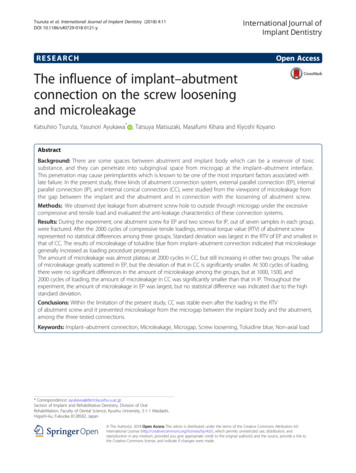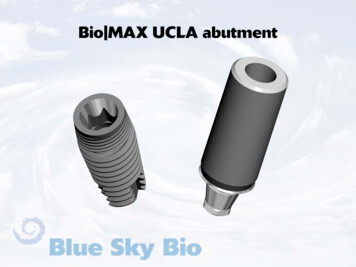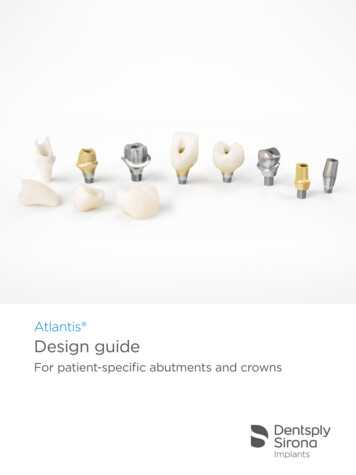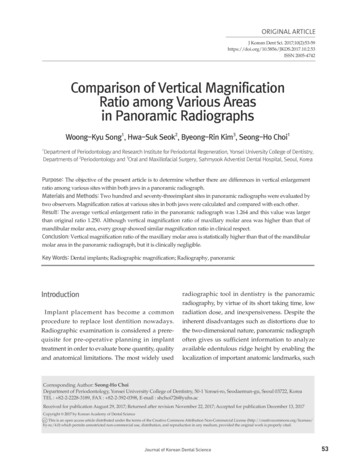
Transcription
Tsuruta et al. International Journal of Implant Dentistry (2018) 4:11DOI 10.1186/s40729-018-0121-yInternational Journal ofImplant DentistryRESEARCHOpen AccessThe influence of implant–abutmentconnection on the screw looseningand microleakageKatsuhiro Tsuruta, Yasunori Ayukawa* , Tatsuya Matsuzaki, Masafumi Kihara and Kiyoshi KoyanoAbstractBackground: There are some spaces between abutment and implant body which can be a reservoir of toxicsubstance, and they can penetrate into subgingival space from microgap at the implant–abutment interface.This penetration may cause periimplantitis which is known to be one of the most important factors associated withlate failure. In the present study, three kinds of abutment connection system, external parallel connection (EP), internalparallel connection (IP), and internal conical connection (CC), were studied from the viewpoint of microleakage fromthe gap between the implant and the abutment and in connection with the loosening of abutment screw.Methods: We observed dye leakage from abutment screw hole to outside through microgap under the excessivecompressive and tensile load and evaluated the anti-leakage characteristics of these connection systems.Results: During the experiment, one abutment screw for EP and two screws for IP, out of seven samples in each group,were fractured. After the 2000 cycles of compressive tensile loadings, removal torque value (RTV) of abutment screwrepresented no statistical differences among three groups. Standard deviation was largest in the RTV of EP and smallest inthat of CC. The results of microleakage of toluidine blue from implant–abutment connection indicated that microleakagegenerally increased as loading procedure progressed.The amount of microleakage was almost plateau at 2000 cycles in CC, but still increasing in other two groups. The valueof microleakage greatly scattered in EP, but the deviation of that in CC is significantly smaller. At 500 cycles of loading,there were no significant differences in the amount of microleakage among the groups, but at 1000, 1500, and2000 cycles of loading, the amount of microleakage in CC was significantly smaller than that in IP. Throughout theexperiment, the amount of microleakage in EP was largest, but no statistical difference was indicated due to the highstandard deviation.Conclusions: Within the limitation of the present study, CC was stable even after the loading in the RTVof abutment screw and it prevented microleakage from the microgap between the implant body and the abutment,among the three tested connections.Keywords: Implant–abutment connection, Microleakage, Microgap, Screw loosening, Toluidine blue, Non-axial load* Correspondence: ayukawa@dent.kyushu-u.ac.jpSection of Implant and Rehabilitative Dentistry, Division of OralRehabilitation, Faculty of Dental Science, Kyushu University, 3-1-1 Maidashi,Higashi-ku, Fukuoka 8128582, Japan The Author(s). 2018 Open Access This article is distributed under the terms of the Creative Commons Attribution 4.0International License (http://creativecommons.org/licenses/by/4.0/), which permits unrestricted use, distribution, andreproduction in any medium, provided you give appropriate credit to the original author(s) and the source, provide a link tothe Creative Commons license, and indicate if changes were made.
Tsuruta et al. International Journal of Implant Dentistry (2018) 4:11Page 2 of 6Fig. 1 A scheme of experimental assembly. a: Abutment and superstructure; b: implant body; c: abutment screw; d: steel mold; e: toluidine bluesolution; and f: waterBackgroundAlthough promising outcome of implant therapy hasbeen reported, periimplantitis which is known to be oneof the most important factors associated with late failure[1] is a serious complication and expected to overcometo obtain successful outcome. It is known that there aresome spaces between abutment and implant body whichcan be a reservoir of microorganisms and other toxicsubstance [2], and they can penetrate into subgingivalspace from microgap located at the implant–abutmentinterface. This is believed to impact to periimplant inflammation [3]. Thus, many kinds of implant–abutmentFig. 2 Removal torque of abutment screw after 2000-cycle loadingconnection have been proposed to minimize the microgap [4].Implant–abutment connection can be divided into threetypes, external parallel connection (EP), internal parallelconnection (IP), and conical connection which has thefriction between the implant and the abutment (CC).Nobel Biocare has implant systems with these three kindsof implant–abutment connections, and these connectionsystems are popular even in other manufacturers and theyalso employ one or some of these connection systems.These systems have a lot of pros and cons and should beselected depending on the dentists’ demand.
Tsuruta et al. International Journal of Implant Dentistry (2018) 4:11Page 3 of 6Fig. 3 a Microleakage from external parallel connection implant–abutment connection. Vertical bars indicate standard deviation. b Microleakagefrom internal parallel connection implant–abutment connection. Vertical bars indicate standard deviation. c Microleakage from internal conicalconnection implant–abutment connection. Vertical bars indicate standard deviationIn the present study, we would like to consider thesethree kinds of connection system from the point of viewof microleakage from the gap between the implant andthe abutment and in connection with the loosening ofabutment screw. We herewith performed the investigationof dye leakage from abutment screw hole to outsidethrough microgap under the excessive cyclic load appliedto cantilever superstructure. Cantilever model couldsimulate non-axial offset loading applied to implant–abutment complex, and toluidine blue solution was used tomeasure the extravasation from the gap at the implant–abutment interface.MethodsThree kinds of Nobel Biocare implants were employedin the present study, namely, Nobel SpeedyGroovy WP5.0 15 mm (EP), Nobel Replace WP 5.0 15 mm (IP),and Nobel Parallel CC RP 5.0 15 mm (CC) (n 7 each)(Nobel Biocare, Kloten, Switzerland). Implant–abutmentconnections are external, internal parallel, and internaland conical connection, respectively. Implant wasembedded into steel mold and fixed with epoxy resin(Araldite , Nichiban, Tokyo, Japan). A superstructurewith cantilever (height 15 mm; length 20 mm from thecenter of access hole) was fabricated using Au–Pt alloy(Degudent LTG, Degudent, Hanau-Wolfgang, Germany)and fixed with abutment screw with fastening torquerecommended by the manufacturer (35 Ncm), usingtorque wrench (Nobel Biocare). Five hundred microliterof water was poured into steel mold, the surface of waterlocated, to small extent, superior to microgap. Then,50 μl of 0.05% toluidine blue solution was poured at theaccess hole (Fig. 1).This assembly was set in a universal test machine(Autograph AS-1S, Shimadzu, Kyoto, Japan), and loadwas applied to the cantilever, at 17.5 mm distance fromthe center of access hole.As one cycle, one compressive and tensile loads (10 Neach) was applied per 1 s and 2000 cycles of loading wasdone. Before starting load application and every 100 cycles,100 μl solutions were collected from pool and absorbanceat 627 nm was measured using a spectrophotometer(Biospec-mini, Shimadzu). Every 500 cycles, the amountof microleakage was statistically compared using Student ttest with Bonferroni correction for multiple comparisons.After the completion of 2000-cycle loading, removaltorque value (RTV) of abutment screw was measured.ResultsDuring the experiment, one (EP) and two (IP) abutmentscrews out of seven samples were fractured. In this case,abutment screw was changed to new one and experimental procedure was re-run.
Tsuruta et al. International Journal of Implant Dentistry (2018) 4:11Page 4 of 6Fig. 4 a Microleakage of toluidine blue from implant–abutment connection at 500 cycles of loading. No statistical difference is indicated (P 0.05).b Microleakage of toluidine blue from implant–abutment connection at 1000 cycles of loading. c Microleakage of toluidine blue from implant–abutment connection at 1500 cycles of loading. d Microleakage of toluidine blue from implant–abutment connection at 2000 cycles of loading. EPexternal parallel connection, IP internal parallel connection, CC internal conical connection. Asterisk indicates statistically significant difference (P 0.05)RTV of abutment screw after 2000-cycle loadingAfter the 2000 cycles of compressive tensile loadings,RTV of abutment screw was measured. There were nostatistical differences in the RTV among three groups.Standard deviation was largest in the RTV of EP andsmallest in that of CC (Fig. 2).Microleakage of toluidine blue from implant–abutmentconnectionAll groups indicated that microleakage generally increased as loading procedure progressed (Fig. 3) andlogarithmic trendline could be drawn, with R2 values of0.854 in EP, 0.924 in IP, and 0.847 in CC. The amount ofmicroleakage was almost plateau at 2000 cycles in CCgroup (Fig. 3c), but still increasing in other two groups(Fig. 3a, b). The value of microleakage greatly scatteredin EP groups (Fig. 3a), but the deviation of that in CCgroup is significantly smaller (Fig. 3c).At 500 cycles of loading, there were no significant differences in the amount of microleakage among thegroups (Fig. 4a), But at 1000, 1500, and 2000 cycles ofloading, the amount of microleakage in CC group wassignificantly smaller than that in IP group (Fig. 4b–d).There were no statistical differences between EP andother groups in every measurement (Fig. 4).DiscussionIn the present study, cyclic tensile and compressive loading were applied to cantilever superstructure. In the clinical situation, both compressive and tensile force wasexerted to implant-supported prosthesis, but no previousstudy has discussed the microleakage using model studyunder this situation. In case of conical connection,compressive force may have promoted a higher penetration of the abutments into implant body, which mayeliminate microgap [5]. But in the clinical situation, tensile force may also be applied to abutment–implant
Tsuruta et al. International Journal of Implant Dentistry (2018) 4:11interface as indicated above; the model employed in thepresent study may be pertinent.Some previous model studies which measured the extent of microleakage from implant–abutment interfaceemployed microorganisms [6–9]. These studies focusedon bacteria itself using visible solution cloudiness test[6], scanning electron microscopy [7], bacteria viabilitytest [8], or checkerboard DNA–DNA hybridizationmethod [9] and did not mentioned about the bacterialtoxin. Toluidine blue employed in the present study caneasily be measured using absorptiometry and it wasreported to be similar to bacterial toxins in its molecularsize [5]. In addition, trend in microleakage was reportedly similar between bacterial leakage model and dyeleakage model [10].In the present study, removal toque of abutment screwafter the cyclic loading showed no statistically significantdifference among the groups. Generally, conical abutment is believed to be better in fit and stability thannon-conical connection [11]. One possibility of this discrepancy may be due to the deformation of abutmentscrew. Actually, implant–abutment connection after theremoval of abutment screw was still tight in CC group,but they were easily divided in other two groups. Thismay indicate that implant–abutment connection in CCgroup was almost sound and intact after the loading. Incontrast, in EP and IP groups, abutment screw may bedeformed which lead to the increase of RTV of abutment screw. The fracture of abutment screws in EP andIP groups may support this speculation. In addition,axial force is strongly affected by the interfacial frictioncoefficient [12]. In the present study, interfacial frictionwas supposed to be largest in CC group because thecontact area between implant body and abutment wassmallest in EP group and both EP and IP groups hadparallel walls at the interface with gaps and voids [13,14]. This may be one reason for the larger standard deviation of RTV in both EP and IP groups.In the present study, chronological increase of theamount of microleakage was observed in all threegroups. This is in consistent with previous studies [5, 13,15, 16]. Sigmoid curves of microleakage in all groupsmeant that the amount of leakage was large at the earlystage of loading. This was in agreement with previousreports. Harder et al. reported that bacterial toxin leakoccurred within 5 min of incubation using in vitro experimental model study, even without application ofloading [15, 16].The comparison of microleakage among the groups atevery 500-cycle load indicated that there were no significant differences among the groups at 500-cycle loadingbut were statistically significant differences in those between IP and CC groups. The reason for microleakagein EP group having no significant differences indicatedPage 5 of 6between EP and IP or CC groups may be due to thelargeness of standard deviation in the value of EP group.The limitation of the present study was the number ofsamples. We believed the sample number (seven in eachgroup) was sufficient to obtain the trends of microleakage,but it may be better to investigate using large number ofsamples to analyze the nature of microleakage at the implant–abutment interface in detail. Another limitation wasthat the fastening torque applied to screw was notnecessarily accurate. To mimic clinical situation, we useddedicated beam-type toque wrench delivered from manufacturer. According to the previous studies, the wrench ofNobel Biocare only reportedly demonstrated the targettorque value falling within the 95% confidence interval forthe true population mean among four kinds of wrenches[17]. In addition, significantly lower deviations of torquevalues for beam-type wrenches were reported than for coiland toggle-style wrenches [18]. But toque wrench still hasan inaccuracy because the scale printed on the wrench isnot fine and it seems to be inappropriate to apply precisetorque value. In the present study, we used new torquewrench, but in the clinical settings, variability of toquevalue may expand because torque wrench is repeatedlyused, with sterilization procedure, which decrease theaccuracy [19].ConclusionsWithin the limitation of the present study, after the offset cyclic tensile and compressive loading, the amount ofmicroleakage from implant–abutment interface wassmaller in conical connection than in internal parallelconnection.FundingThe experiment was done by self-funding.Authors’ contributionsYA contributed to the establishment of the concept of this work, data acquisitionand analysis, drafting the paper, and final approval of the work. KT contributedto the establishment of the concept of this work, data acquisition and analysis,drafting the paper, and final approval of the work. TM contributed to the dataacquisition and analysis, drafting the paper, and final approval of the work. MKcontributed to the data acquisition and analysis, drafting the paper, and finalapproval of the work. KK contributed to the data acquisition and analysis, draftingthe paper, and final approval of the work.Ethics approvalThe present study was not required ethical approval.Competing interestsKatsuhiro Tsuruta, Yasunori Ayukawa, Tatsuya Matsuzaki, Masafumi Kihara,and Kiyoshi Koyano declare that they have no competing interests.Publisher’s NoteSpringer Nature remains neutral with regard to jurisdictional claims in publishedmaps and institutional affiliations.
Tsuruta et al. International Journal of Implant Dentistry (2018) 4:11Received: 20 November 2017 Accepted: 24 January 2018References1. Sakka S, Baroudi K, Nassani MZ. Factors associated with early and late failureof dental implants. J Investig Clin Dent. 2012;3:258–61.2. Tallarico M, Canullo L, Caneva M, Ozcan M. Microbial colonization at theimplant-abutment interface and its possible influence on periimplantitis: asystematic review and meta-analysis. J Prosthodont Res. 2017;61:233–41.3. Sasada Y, Cochran DL. Implant-abutment connections: a review of biologicconsequences and peri-implantitis implications. Int J Oral MaxillofacImplants. 2017;32:1296–307.4. Liu Y, Wang J. Influences of microgap and micromotion of implantabutment interface on marginal bone loss around implant neck. Arch OralBiol. 2017;83:153–60.5. da Silva-Neto JP, Prudente MS, Dantas TS, Senna PM, Ribeiro RF, das NevesFD. Microleakage at different implant-abutment connections underunloaded and loaded conditions. Implant Dent. 2017;26:388–92.6. Aloise JP, Curcio R, Laporta MZ, Rossi L, da Silva AM, Rapoport A. Microbialleakage through the implant-abutment interface of Morse taper implants invitro. Clin Oral Implants Res. 2010;21:328–35.7. Dibart S, Warbington M, Su MF, Skobe Z. In vitro evaluation of the implantabutment bacterial seal: the locking taper system. Int J Oral MaxillofacImplants. 2005;20:732–7.8. Silva-Neto JP, Prudente MS, Carneiro Tde A, Nobilo MA, Penatti MP, NevesFD. Micro-leakage at the implant-abutment interface with differenttightening torques in vitro. J Appl Oral Sci. 2012;20:581–7.9. do Nascimento C, Barbosa RE, Issa JP, Watanabe E, Ito IY, de AlbuquerqueJunior RF. Use of checkerboard DNA-DNA hybridization to evaluate theinternal contamination of dental implants and comparison of bacterial leakagewith cast or pre-machined abutments. Clin Oral Implants Res. 2009;20:571–7.10. Piattelli A, Scarano A, Paolantonio M, Assenza B, Leghissa GC, DiBonaventura G, et al. Fluids and microbial penetration in the internal part ofcement-retained versus screw-retained implant-abutment connections.J Periodontol. 2001;72:1146–50.11. Schmitt CM, Nogueira-Filho G, Tenenbaum HC, Lai JY, Brito C, Doring H,et al. Performance of conical abutment (Morse Taper) connection implants:a systematic review. J Biomed Mater Res A. 2014;102:552–74.12. Egol KA, Kubiak EN, Fulkerson E, Kummer FJ, Koval KJ. Biomechanics oflocked plates and screws. J Orthop Trauma. 2004;18:488–93.13. Tsuge T, Hagiwara Y, Matsumura H. Marginal fit and microgaps of implantabutment interface with internal anti-rotation configuration. Dent Mater J.2008;27:29–34.14. Scarano A, Valbonetti L, Degidi M, Pecci R, Piattelli A, de Oliveira PS, et al.Implant-abutment contact surfaces and microgap measurements ofdifferent implant connections under 3-dimensional X-ray microtomography.Implant Dent. 2016;25:656–62.15. Harder S, Dimaczek B, Acil Y, Terheyden H, Freitag-Wolf S, Kern M. Molecularleakage at implant-abutment connection—in vitro investigation of tightnessof internal conical implant-abutment connections against endotoxinpenetration. Clin Oral Investig. 2010;14:427–32.16. Harder S, Quabius ES, Ossenkop L, Kern M. Assessment oflipopolysaccharide microleakage at conical implant-abutment connections.Clin Oral Investig. 2012;16:1377–84.17. Britton-Vidal E, Baker P, Mettenburg D, Pannu DS, Looney SW, Londono J,et al. Accuracy and precision of as-received implant torque wrenches.J Prosthet Dent. 2014;112:811–6.18. Neugebauer J, Petermoller S, Scheer M, Happe A, Faber FJ, Zoeller JE.Comparison of design and torque measurements of various manualwrenches. Int J Oral Maxillofac Implants. 2015;30:526–33.19. Stroosnijder E, Gresnigt MM, Meisberger EW, Cune MS. Loss of accuracy oftorque wrenches due to clinical use and cleaning procedure: shortcommunication. Int J Prosthodont. 2016;29:253–5.Page 6 of 6
parallel connection (IP), and internal conical connection (CC), were studied from the viewpoint of microleakage from the gap between the implant and the abutment and inconnection with the loosening of abutment screw. Methods: We observed dye leakage from abutment screw hole to outside through microgap under the excessive









